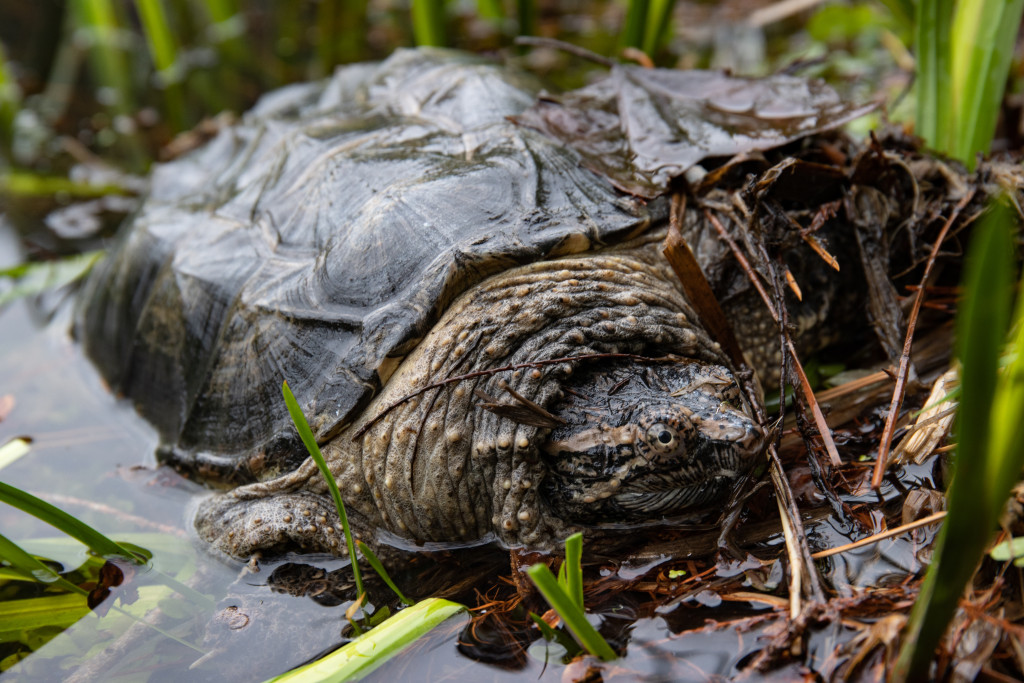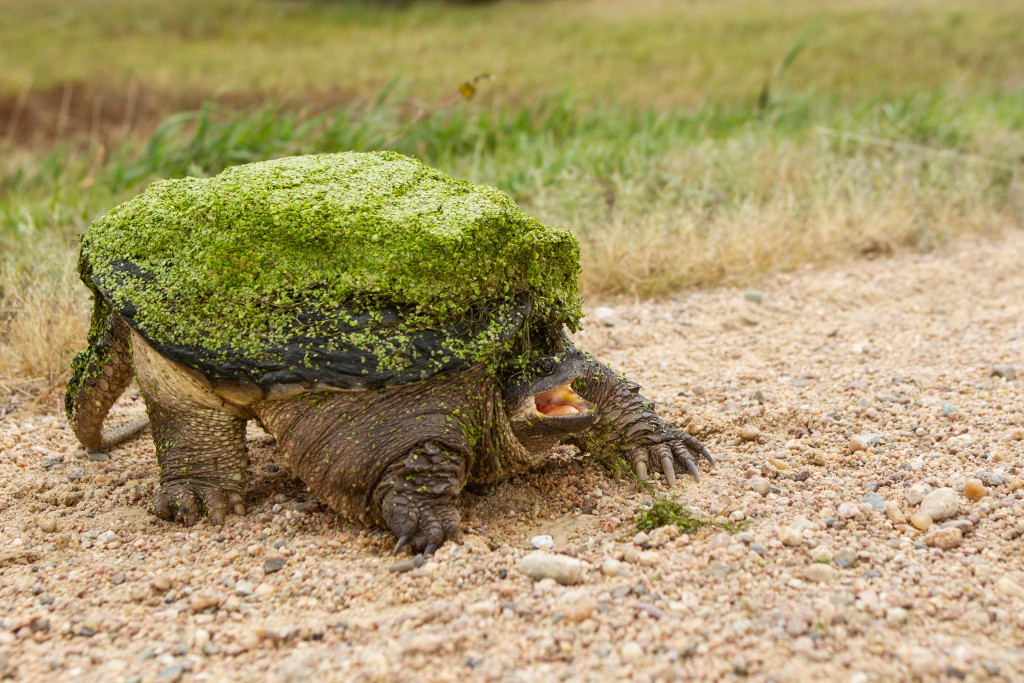Enlarge

By Monica Macoubrie, Wildlife Education Specialist
This is a familiar sight in Nebraska: You’re driving along a two-lane highway listening to the radio, when all of a sudden, a dinosaur walks across the road just ahead of you. OK, not literally a dinosaur, but a living creature that is as close as you can get — a snapping turtle.
As you approach the turtle, you notice that it’s earnestly on a mission, however slow and lumbering. It’s trying to make its way from one side of the road to the other. You might think to yourself, “Why does a turtle need to cross the road?” Well, there are many reasons. One common reason is that it’s a female snapping turtle looking for a nesting site. Alternatively, if it is anytime between August and October, vulnerable young hatchlings may be the ones lumbering across the road to head toward the shelter of water.
The snapping turtle is one of Nebraska’s largest turtle species. It can be found throughout the state in just about every habitable body of water, including lakes, rivers and ponds. These turtles have a large head, long tail and an extremely reduced plastron, or bottom shell. The carapace, the top shell, can range in color from brown to gray to almost entirely black. The carapace also has three peaks as well as serrations toward the back, near the tail. Snapping turtles range from 9-15 inches long, or longer, and weigh up to 50 or more pounds.

Turtles don’t reach sexual maturity like most other animals. Age is not an indication of when a turtle is ready to reproduce. Instead, a turtle’s size is the better indicator. On average, snapping turtles reach sexual maturity when they are around 8 inches from snout to vent (cloaca). Once sexually mature snapping turtles come across members of the opposite sex, they begin courtship by facing one another and moving their heads from side to side. The male will then begin to mount the female, adjusting his tail beneath the female’s tail to allow their cloacal openings (mating area) to touch. Once mating is successful, a female snapping turtle can keep sperm viable in her body for several years, so that eggs can be fertilized even in years when she does not have the opportunity to mate.
Nesting season for these animals is usually around April through November, peaking in May and June. Snapping turtles hardly ever leave their aquatic habitats except during breeding season. During this time, females can travel great distances to search for places to dig nests and lay eggs; snapping turtle nests have been recorded a mile or more away from the nearest water source. Selected nest sites could include muskrat burrows, gardens, lawns, golf courses, road embankments and river banks.
Female turtles usually lay a clutch of eggs in May or June. She will use her powerful hind claws to dig a shallow, bowl-shaped nest in a well-drained, sunny location. During egg laying, which could take a few hours, the female will lay anywhere from 20-40 eggs. These eggs feel leathery, and they are about the size of ping pong balls.

Snapping turtles have what scientists call “temperature sex determination,” meaning that whatever temperature the egg(s) is exposed to will determine the turtle’s sex. Eggs that are kept in cooler temperatures, around 68-70 degrees, will produce only females. Eggs that are maintained in a 70- to 72-degree environment could produce males or females, and eggs that are kept in higher in temperatures, 73-75 degrees, produce only males. Here’s a fun little saying to help you remember: “Girls are cooler than boys.”
After laying, the female will then cover the eggs and return to the water. Like other turtle species, female snappers do not tend to nests and care for their young. Nests are extremely vulnerable, often preyed on by raccoons, skunks and even crows. Studies show that nearly 90 percent of snapping turtle nests are destroyed by predators annually.
Hatching takes around 80-90 days, but can vary depending on the temperature and the environment. Hatchlings will usually emerge from their leathery eggs anywhere between August and October. To emerge from the egg, hatchlings develop an egg tooth, which then disappears around three or so days after breaking out of the egg. These baby turtles are then on their own to find a spot to bromate (hibernate) for the winter and hopefully, survive into adulthood.
The post Snapping Turtle Hatching appeared first on Nebraskaland Magazine.
















